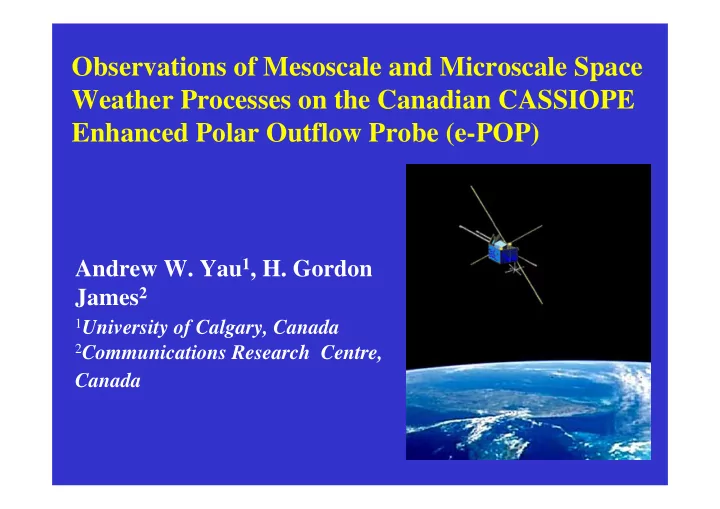

Observations of Mesoscale and Microscale Space Weather Processes on the Canadian CASSIOPE Enhanced Polar Outflow Probe (e-POP) Andrew W. Yau 1 , H. Gordon James 2 1 University of Calgary, Canada 2 Communications Research Centre, Canada
e-POP Science Payload: to study space storms – plasma outflows, radio propagation, aurora, and ionosphere non-uniformities + Small-Sat Bus : Generic, low-cost satellite = bus to address needs of future Canadian small-satellite missions + CASSIOPE Cascade Technology Payload: to demonstrate high bandwidth store-and- forward data delivery
Outline 1. e-POP Science Targets Physics of space weather effects in ionosphere-thermosphere 2. Meso-/Micro-scale Space Weather Processes Existing Observations 3. e-POP Instruments & Measurements 4. Planned e-POP Studies of Space Weather Processes 5. Conclusions
e-POP Science Targets Physics of space weather effects is overarching theme. • Ion acceleration and outflow Meso-scale outflow; micro-scale wave particle interaction • Ionospheric irregularities and scintillations 3D irregularities; GPS occultation GPS • Effects on radio wave propagation Trans-ionospheric radio wave propagation • Thermospheric expansion Thermosphere heating, composition changes, and escape SuperDARN • Aurora Small-scale auroral and auroral current structures
2. Meso-scale and micro-scale space weather processes Existing Observations
Thermal and Suprathermal Ion Outflows Observations (Cully et al. 2003) Suprathermal (>10 eV) >16000 km (DE-1) Suprathermal (>15 eV) < 9000 km (Polar) Thermal (<20 eV) <9000 km; (Akebono) Physical Significance Outflow rate increases >10-fold at high Kp Significant H + acceleration above 9000 km Significant O + acceleration below 9000 km Large-scale depletion of ionosphere!? Space weather effects?
Ion Heating and Lower Hybrid Solitary Structure Ion distributions at 980 km (Burchill et al., 2004) Observations 10- to 100-m ion heating and lower hybrid solitary structures Transversely accelerated ions 40 ms Heated ions at several eV 63 ± 25 m width LHSS signatures Density depletion ∼ 15%; ∼ 10 ms Associated w/ TAI and/or BB VLF Physical Significance Large field and acceleration at small scale Affect larger-scale space weather effects? “Spikelet” electric fields at ~600 km (LaBelle et al. 1986)
← 10.1 km → Small-scale Auroral Structures <Wavelength> = 4 km 415 curls Observations Maxium: 18 km Auroral spatial scales: 10-100 km (bands), to 0.1-1 km (curtains) <Speed> = 10 km/s 311 non-zero velocity curls Auroral curls IBC III/IV: 13 km/s IBC I/II: 6 km/s Maximum: 90 km/s Scale ∼ 4 km; ∼ 2 s Anti-clockwise rotation; 10 km/s Physical Significance <Lifetime> = 2.3 s 301 curls Are small (sub-km) structures important? IBC III/IV: 0.9 s IBC I/II: 4.8 s Maximum 46 s
Thermospheric Response to Magnetic Storms Observations Thermosphere expansion (temperature and density increase) in magnetic storms Equatorial propagation of expansion More localized response to substorms Physical Significance Large neutral wind; composition change From CHAMP at 410 km (Sutton et al. 2005) Anomalous orbit decay in polar LEO
3. e-POP Instruments and Measurements
e-POP Mission Approach In-situ, small-scale plasma, waves, fields at highest resolution Radio wave propagation: ionospheric irregularities in 3D Fast imaging of meso-scale auroral morphology Polar orbit in key transition region (325 × 1500 km; 80 ° inclination) 3-axis stabilized S/C for imaging and high-resolution measurements Large data capacity (TB storage, >10GB/day, >300 Mbps downlink)
e-POP Instrument Principal Investigators Science Instrument Principal Investigator IRM Imaging ion mass spectrometer Dr. Peter Amerl University of Calgary SEI Suprathermal electron imager Dr. David Knudsen University of Calgary NMS Neutral mass/velocity spectrometer Dr. Hajime Hayakawa JAXA/ISAS, Japan FAI Fast auroral imager Drs. Sandy Murphree and Leroy Cogger University of Calgary RRI Radio receiver instrument Dr. Gordon James Communications Research Centre MGF Magnetic field instrument Dr. Donald Wallis Magnametrics and University of Calgary GAP GPS attitude/profiling experiment Dr. Richard Langley University of New Brunswick CER Coherent EM radio tomography Dr. Paul Bernhardt Naval Research Laboratory, USA
e-POP Plasma Outflow Instruments: will measures ions, electrons, and neutrals at up to 10-ms resolution Electrons electrons ions neutrals IRM SEI NMS MGF Space storm results in electrical current and IRM, SEI, NMS, MGF will measure ions, plasma outflow in the ionosphere. electrons, neutrals, and electrical currents.
4. Planned e-POP Studies of Space Weather Processes
Examples of Planned e-POP Studies • Detailed dynamical characteristics of polar wind; Role of escaping atmospheric photoelectrons • Exosphere neutral outflows: Role of polar wind, charge exchange, and other acceleration processes • Micro-scale ion heating/energization characteristics: Connections between aurora, ion energization and upflow • Wave particle interaction associated with ion energization: detailed wave propagation characteristics • Plasma instabilities: creation of F-region density structure, growth and saturation of instabilities, constraints on flow
Planned e-POP Observations and Studies • In-situ Observations* – Plasma, Neutral, Magnetic Field Radio (Electric Field) – Optical (IR and visible) imaging – Radio occultation (GPS, beacon) • Coordinated ground observations* – Radio: SuperDARN, CADI etc – Others: CGSM, … – Active Experiment: HAARP etc • Data assimilation and modeling* – Kinetic, MHD, … * Collaborative opportunities being pursued
E-POP Science Team & Participating Organizations Communications Research Centre: HG James, P Prikryl Royal Military College: JM Noel U. Alberta: R Rankin, C Watt U. Athabasca: M Connors U. Calgary: P Amerl, L Cogger, E Donovan, D Knudsen, JS Murphree, T Trondsen, D Wallis, A Yau U. New Brunswick: A Hamza, PT Jayachandran, D Kim, R Langley U. Saskatchewan: G Hussey, S Koustov, G Sofko, JP St Maurice U. Victoria: R Horita U. Western Ontario: L Kagan, J MacDougall York U: J Laframboise, J McMahon JAXA/ISAS, Japan: T Abe, H Hayakawa, K Tsuruda NRL, USA: P Bernhardt, C Siefring UNH, USA: M Lessard
Recommend
More recommend